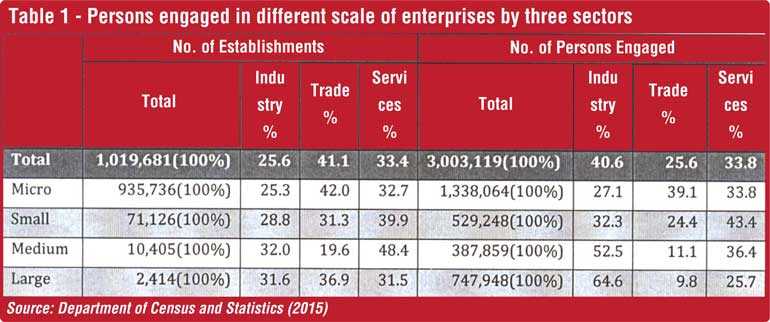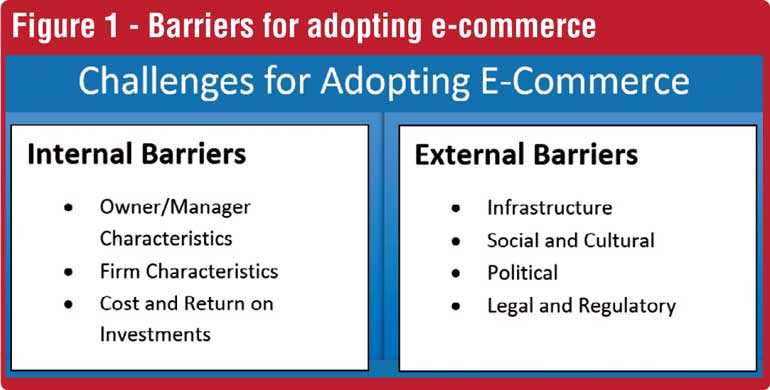Friday Dec 26, 2025
Friday Dec 26, 2025
Wednesday, 28 April 2021 00:00 - - {{hitsCtrl.values.hits}}

The contemporary world economy is transforming from traditional business to digital business by using internet and electronic commerce
 Introduction
Introduction
Due to COVID-19, many industries and sectors have struggled throughout this year; e-commerce has seen a highly successful 2020. Its growth has been massive and is set to continue well into 2021. It has even affected the spending patterns of most consumers. So, growth of e-commerce is the new-born business method, which has originated through an extensive usage of IT in their business. Hence, the main objective of this article is to identify the full potentials of e-commerce in developing the SME sector in Sri Lanka and the sub-objective is to identify the significance of the SME sector in Sri Lankan economy, to identify the important of e-commerce in SMEs, and to recommend policy implications to overcome these barriers.
The internet and electronic commerce have made the world market a smaller place to trade in. E-commerce may be defined as ‘The sharing of business information, maintaining business relationships, and conducting business transactions by means of Internet-based technology’ (Riggins &Rhee, 1998, p. 90). The Internet has opened up many possibilities of organising and running an online business. It has created a universal platform for buying and selling of goods which has resulted in faster transaction times and reduced transaction costs. Colin Turner (2000), in his book on the information of e-economy, talks about the e-commerce business accomplishment and strategies.
The Sri Lankan Government is currently on the process of upgrading the Internet infrastructure and developing it in the form of installation of a super-fast telecommunication network. This is mainly due to the fact that Sri Lanka is unable to meet the changing requirements in the World Wide Web due to its weak and poor infrastructure. The rapid advancement in both Internet software and hardware has also led to more and more organisations allocating resources to meet the changing requirements in e-commerce. Large corporations, Small and Medium Enterprises (SMEs) and individuals are all investing more and more in the internet business (Kennedy D. Gunawardana, 2018).
SMEs sector’s contribution
In this background, Small and Medium Enterprises (SMEs) play a vital part in all economies and very often are recognised as the growth engine of the economy. These institutions have received this vital place in the economy through its contribution in terms of wealth creation, employment generation, poverty and inequality reduction (Rashid et.al, 2001).
Since 1948, successive governments have introduced various development programs to facilitate and promote SMEs in different sub sectors of the economy. Because, these governments have identified the potentials of SMEs in expanding the national economy.
Sri Lankan SMEs represent a high percentage of the total number of business established in the country, highly involved in import substitution and export diversification and thereby contribute towards minimising balance of payment deficit (Hewaliyanage, 2001). According to Ponnamperuma (2000) SMEs with fixed assets of Rs. 16 million or less represented 90% of all enterprises, 70% of total employment and 55% of gross value added to the private sector. Table 1, shows the distribution of establishments and persons engaged in different scales of enterprises by three sectors. This table proves that SMEs in Sri Lanka represent the highest number of establishments and persons engagement.
Nevertheless, the inevitable truth is the Sri Lankan SME sector is a very fragile sector which requires close nurturing, incentives, financial support, institutional support, business development services and less regulated business environment. And the most important lacking ingredients are the technological knowledge, support and facilities. The contemporary world economy is transforming from traditional business to digital business by using internet and electronic commerce (e-commerce). Because, through this strategy enterprises including small and medium scale have the ability to reduce costs, expand market places, improve business image, enhance competitiveness and increase profits.
Global experience of e-commerce in SME sector
As mentioned earlier the SME sector is a very fragile sector that faces various constraints and barriers. To overcome most of these barriers, the SME sectors in developed and some of the developing countries are moving towards digital business using e-commerce. According to UNDP (2004), “Developing countries have the potential to achieve rapid and sustainable economic and social development by building an economy based upon an ICT enabled and networked SME sector capable of applying affordable yet effective ICT solutions”. If Sri Lanka is going adopt this strategy we should identify the potentials and advantages of e-commerce in the developing SME sector.
Indonesia as a developing nation is still at the bottom level in e-commerce and in e-business due to lack of IT infrastructure, security measures to facilitate online payment, awareness of the potential of e-business, availability of IT skills and willingness to change business practice especially among individual household and small to medium sized enterprises. Kurnia (2006), has identified that despite these limitations e-commerce offers excellent opportunities for micro and macro-economic growth in Indonesia. Therefore, Indonesian government is always provide various initiatives to develop awareness and educational campaign on ICT, develop programs to support SME’s involvement in ICT and e-commerce, revising tax law to facilitate electronic transaction and many others.
According to Intrapairot and Srivihok (2003), rapid change s in information and communication technology are forcing SMEs in Thailand towards e-commerce despite the uncertainty of its actual benefits (Intrapairot and Srivihok, 2003). If they are reluctant to adopt e-commerce, they may lose their market. This reveals that consumers in Thailand are highly demanding e-commerce. Therefore, SMEs in Thailand have identified e-commerce as a tool to face competition in the market.
In Malaysia, SME holders possess below-average ICT skills and rarely use the internet at their workplace. This leads to low adoption of e-commerce among SMEs in Malaysia. As a solution Hashi0m (2007) is pointing out the significant role of the government in promoting and supporting ICT skills among SME owners.
When considering these studies, we can identify some common characteristics. One characteristic is, SME sectors in these developing nations are moving towards e-commerce, second characteristic is, they all face some common issues in adopting e-commerce to SMEs and the third characteristic is, all these studies recommend government assistance in promoting e-commerce in SME sector.
Challenges to adopt e-commerce for SME sector in Sri Lanka
The main challenge for these SMEs in adoption of e-commerce is the lack of facility and resources according to changing needs of the customers. The large corporations are finding no difficulties in their concurrence in the e-commerce world mainly because they have large resources and facilities compared with the SMEs.
With the ICT revolution in the country around the year 2000, entrepreneurs started to utilise ICT for the development of SMEs. The Government and some private institutions have taken some initiatives to promote ICT for the development of SMEs. With these initiatives SME holders in Sri Lanka are trying to adopt e-commerce to their business activities because, this strategy has the ability to reduce costs, expand marketplaces, enhance competitiveness, and improve company image and revenue.
Another challenge addressed is why SMEs are reluctant or are not prompted to adopt e-commerce to develop of day to day business. The most frequently used e-commerce activities are the internet, email and websites. The least used activities are electronic data interchange, making purchases online, online payment, customer relationship management, e-customer service and video conferencing. Overall, what was found was that the SME holders use only the basic or low-level e-commerce activities to carry out day-to-day operations.
The barriers faced by the SMEs in developed countries are completely different than the barriers face by SMEs in developing countries. All SME holders in Sri Lanka do not have equal ability or strength to adopt e-commerce to their business activities. Because they will face enormous barriers in the process of adopting e-commerce. These barriers can be divided into two major categories;
Internal Barriers – obstacles that arise within the organisation
External Barriers – obstacles arise due to infrastructure, political, legal, social and cultural barriers that exist in the country
Moving to internal barriers faced by SME holders in Sri Lanka, again it can be divided into three categories as given in Figure 1. In owner/manager characteristics, existing literatures are mainly highlighting lack of knowledge in how to use technology and low level of computer literacy. Though Sri Lanka’s overall literacy rate is high comparative to other developing countries, computer literacy among entrepreneurs is very low. Under firm characteristics, low level of technology usage is the main barrier. Still most of the SMEs in Sri Lanka use primitive sources for production and marketing, and use limited technology for these activities. Therefore, adoption of e-commerce has become very difficult.
Another type of internal barrier face by SMEs is cost and return on investments. This barrier arises due to high cost of developing the digital network, wed site, etc., and the uncertainty of expected returns of their investments.
On the other hand, external barriers also can be divided into subcategories: infrastructure barriers, social and cultural barriers, political barriers and legal and regulatory barriers. Infrastructure barriers include of fixed telephone lines for end user dial-up access and poor internet connectivity. Another infrastructure barrier is unequal distribution of bank facilities around the country. Internet banking facilities and credit card facilities are mostly provided in urban areas not in rural areas. Since most of the SMEs are located in rural areas this has become a major barrier for e-commerce adoption. In countries like Sri Lanka not only entrepreneurs, consumers also have little knowledge about ICT and their trust towards digital transaction also limited. This situation can be identified as social and cultural barrier. Moreover, earlier governments in Sri Lanka paid little attention on promoting e-commerce among SMEs.
Way forward
In the competitive world of e-commerce business, entrepreneurs always try to find techniques, tips, and tricks in order to increase the branding of the business and the customer’s loyalty. There is a wide variety of strategies that helps in marketing and increases the visibility of the business. There are uncountable e-commerce techniques and strategies that effectively help in thriving the businesses.
Generally, SME holders, whenever need to announce any promotions or their deals and discounts, creating a hype is a great deal. Hype can be created on all the social platforms such as on Facebook, Instagram, and emails. Usually, Facebook users spend around 50 minutes each day on its multiple platforms. Announcing their promotions on social media helps in enhancing the engagement and interaction with the customers. Also, user-generated content (UGC) is an effective way to attract customers toward their brand. User-generated photos are also a great way of generating a social proof. It further increases the sales of the brand. Their announcements make the customers excited about the sales and promotions of their business and increases the conversion rates of their business.
To improve the reliability of payments over internet the policy makers can develop a legal framework to enhance the trust over online payment. With this legal framework willingness of customers to engage with online payments will increase. More over to remove the uncertainty of expected returns on investment on e-commerce, respective authorities should implement awareness programs to reduce cost attached digital networks, website, etc., and increase revenue through e-commerce.
When it comes to external barriers, all the barriers related to infrastructure category can overcome with various development programs. In this case the Government should take the leading role because we cannot expect the private organisations will take these types of major development initiatives. Moving to social and cultural challenges that were discussed earlier, these challenges can be overcome by conducting training and awareness programs to explain the benefits customers can acquire with e-commerce. Furthermore, political challenges can overcome by establishing a national policy in SME development which will not be affected by government turnovers and by introducing a tax system which will promote e-commerce. For instance, reduce tax telecommunication devices.


(S. Thanigaseelan is Assistant Director, National Human Resource Development Council of Sri Lanka and Navoda Edirisinghe is Research Officer at the National Human Resources Development Council of Sri Lanka.)